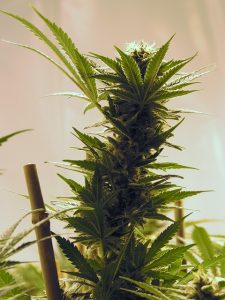How Much Negative Pressure Should a Grow Tent Have?
Do you have a grow tent? Are you finding that the walls of the tent appear to be sucking inward? If so, then you most definitely have some negative pressure happening. The way grow tents are constructed now, it is more common to have this happen, especially when you have an inline fan forcing air out of the tent and no air being vented back in. Think of a juice box and what happens when you get to the bottom – the box collapses inward. That’s negative pressure.
How much negative pressure should a grow tent have? A grow tent should have even pressure, meaning just as much air being vented in as being forced out. However, keeping a slightly negative pressure will make it easier to keep consistent temperatures and humidity in the grow tent. Marijuana plants will grow better in negative pressure, rather than excessive positive pressure. It’s a bit of a balancing act.
Using my juice box example should give you an idea of what negative pressure looks like. In this article, we will look at what causes negative and positive air pressure in grow tents as well as what you can do to get your tent just how you want it. I will explain what CFM is and how you can use it to adjust the airflow in your tent. We will also look at a couple other related questions on this topic. So, let’s get started.
Is Negative Pressure Bad in a Grow Tent?
A small amount of negative pressure is not bad. In fact, a small amount is quite normal, especially for shorter amounts of time. If you are using inline ventilation and have the inlet and outlet venting on timers, possibly they are turning on at completely different times, which would make sense as to there being negative and positive pressure periodically.
Another thing to consider is how does negative pressure affect your pot plants?
I feel it is beneficial to have a slightly negative pressure versus positive pressure and here’s why.
- Having negative pressure means you are better able to stabilize the temperature and humidity of the grow tent so there is less stress on the plants.
- Therefore, this must mean then that when there is more positive pressure, the temperature and humidity are then harder to keep consistent. It only makes sense. More fresh air coming in will have an unstable humidity level and temperature.
Thusly, we can assume that having negative pressure in a grow tent is not a bad (but rather a good) thing for the growing success of your plants.
Something else to take away here is having negative pressure means you are not dispelling as much smell from the inside of the tent to outside. If the smell of your plants being noticed is a concern of yours, then keeping your tent in a bit of negative pressure is something you will be interested in.
How Do You Create Negative Pressure in a Grow Room/Tent?
First, let me just say that you don’t necessarily have to have negative or positive pressure in your grow tent. If you don’t have any inline ventilation hooked-up, then you will be sitting at an even room air pressure. Does that make sense?
If you decide having a bit of negative pressure is best for your grow tent, then what you need to do is make sure your intake is running less than your outlet for any ventilation you are running. That’s it.
Be aware, though, that once you open the zipper on the tent, the air pressure will once again be equalized, which is just fine and can be expected. The plants need water, nutrients and some form of attention.
Something you might run into when searching online for negative pressure is the term CFM. CFM means cubic feet per minute. It is the way to measure the air movement by a piece of equipment such as an inline vent for a grow tent.
So why is this important? Well, if you have a grow tent and you want to exchange the air in it a certain amount of times, you need to understand this. It’s quite simple, yet after looking around online, so many articles are over complicating the matter. It’s just not necessary. Let me explain this as easily as possible.
- To figure out the cubic feet of your grow tent, multiply the width and depth and height. Then, multiply those together. I have a tent that is 4’x2’ by 5’ high. So, it would be 4 x 2 x 5 which equals 40.
- Therefore, my grow tent has 40 cubic feet.
- It is generally recommended that air be replaced every 3 minutes in the tent, so you would then divide the 40 by 3 which equals 13.33.
- This means I would need to get inline ventilation fans that can handle a CFM of 13.33, if I want the air in the tent exchanged every 3 minutes. Make sense?
- Remember, CFM means cubic feet per minute and you are calculating how many cubic feet per minute your fan will exchange or move the air.
There are so many fans to choose from so how do you know which ones to pick?
I would say always go with companies that also make grow tents or cater to grow tents for marijuana. For instance, this inline ventilation kit is an excellent choice and just a good place to start.

Is it Better to Have Positive or Negative Pressure in a Grow Tent?
We touched on this a bit so far in this article. I think what is better as far as positive or negative pressure is concerned depends on the grower and region you are in.
This is a preference in my mind. I prefer a bit of a negative pressure in my tent, as I know I can keep the temperature and humidity stable for longer periods of time.
You might not care and just want as much fresh air in the tent as possible. If that’s the case, you either want more of a positive pressure or an even air flow between the intake and out with your vent fans running more often.
How Often to Run an Exhaust Fan in a Grow Tent?
This will depend on you. If you feel you need to run the fans hourly, once day or even less. Some growers feel they need a constant breeze on their plants to help strengthen them. You can do that by using a portable fan inside the grow tent instead of opening-up the ventilation. Or, simply run the in and out ventilation to create that air flow.
If you are new to growing marijuana, you will figure out what works for you.
How to Regulate Air Pressure in a Grow Tent?
We have gone over this throughout the article in different sections. If you know how much fresh air you want to be drawn into the tent and how often, you now have the knowledge to figure that out and make it happen.
It’s all about your preferences and knowing how to calculate CFM.
Do you need fresh air in a sealed grow room?
Yes, you sure do. You will get some fresh air into the tent just by opening-up the zipper and as discussed throughout this article, having inline ventilation will help you make that happen even when you are not opening the grow tents door.
One of the reasons you must have fresh air in the tent from time to time is to prevent mold from growing. Of course, this is part of controlling humidity which in part is using ventilation. If you ever find the inside walls of your tent are dripping with water droplets, then you have too much humidity. Get some fresh air in the room immediately and turn off your humidifier, if you’re using one. Get that fixed ASAP. I like to keep my room around 50% humidity.
Do I Need an Intake Fan in a Grow Tent?
No, you do not need an intake fan in a grow tent. Many people grow without them. They just make the process of moving air and smells much easier. Newer technology and manufacturing are providing your regular grower the opportunity to include these pieces of equipment now at reasonable prices so why not?
The key here is just making sure there is fresh air being introduced periodically to your plants, regardless of how it gets there.
Another question might be, will using an intake fan make my grow better? Yes! I think combined with an outlet fan you grow will be better. Don’t forget to include carbon filtration to help absorb smells coming from the plant. Just because you really enjoy how your plants smell doesn’t mean others do!
Conclusion
There you have it, all kinds of useful information. When it comes right down to it, you don’t want the sides of your grow tent looking like they are imploding. If that’s the case, then you have too much negative pressure. Having slight tightness on the tent walls is just fine and probably normal when running inline ventilation.
Just remember, an easy fix is to just open your zipper and turn the fans off. Don’t open the tent, though, when it’s nighttime for the plants and wait until the lights are on if, you can.
*Ventilation kits are very affordable like this one over on Amazon.*
Keeping track of your temperature and humidity are much more important than negative pressure on a grow tent, so make sure those parameters are in-check on a daily basis.
Related Growing Marijuana World Articles
What Size Pot for Growing Weed
Best Temperature and Humidity for Grow Tents
How Much Area Does a 1000Watt Grow Light Cover?
Do LED Grow Tents Need Ventilation?









